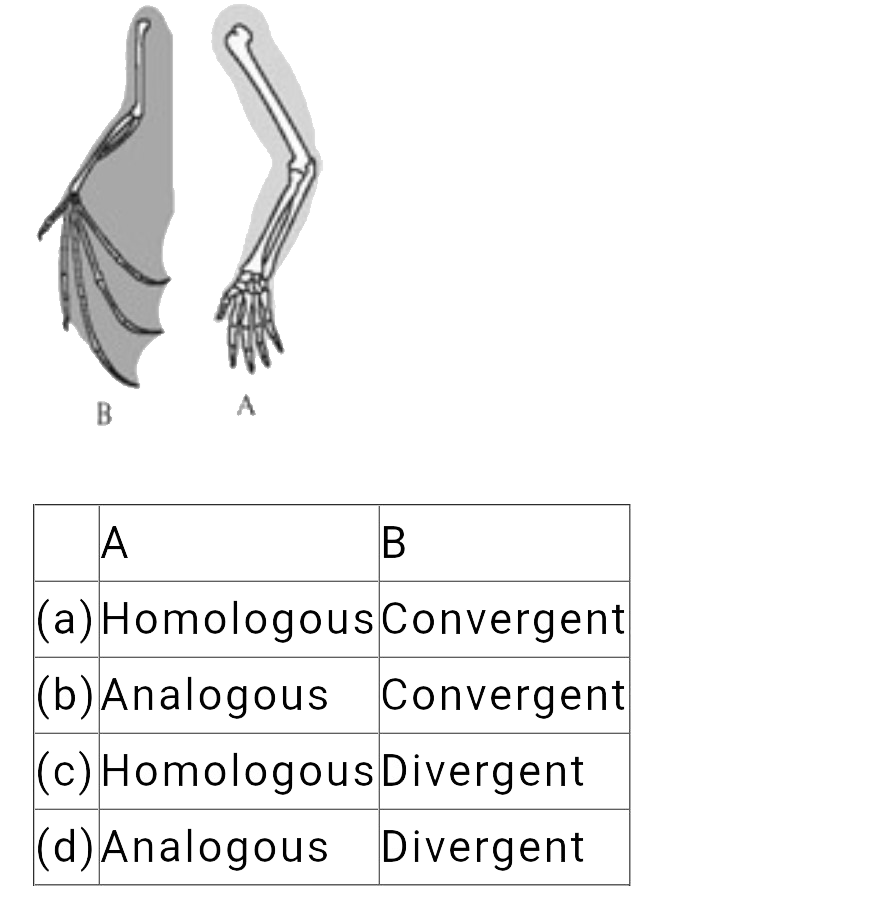[A]: Convergent evolution leads to production of analogous similarities among different groups of organisms.
[R]: Animals of the same group or closely related groups exhibit great divergences in their morphologySolution in Bengali
If both A and R are true and R is the correct explanation of A
If both A and R are true but R is not the correct explanation of A
If A is true and R is false
If both A and R are false
The correct Answer is:B
Step by step video & image solution for [A]: Convergent evolution leads to production of analogous similarities among different groups of organisms. [R]: Animals of the same group or closely related groups exhibit great divergences in their morphology by Biology experts to help you in doubts & scoring excellent marks in Class 12 exams.
Updated on:21/07/2023Topper's Solved these Questions
Similar Questions
[A] : Endomycorrhiza of forest trees contribute to the efficient nutrient cycling in tropical test ecosystems .
[R] : The fungi that form endomycorrhizal association with plants store nutrient ions and make them available to the host plants .
View SolutionWhich Mendel's law of inheritance is universally acceptable and without any exception? State the law
View SolutionA group of individual organisms with fundamental morphological similarities is called?
View Solution[A]: Convergent evolution leads to pro_duct1on of analogous similarities among different groups of organisms.
[R]: Animals of the same grou~ or closely r~- lated groups exhibit great divergences in their morphology
View SolutionA and B are examples of ………………i………… organs and represent ………..ii…………… evolution .

AB(a)HomologousConvergent(b)AnalogousConvergent(c)HomologousDivergent(d)AnalogousDivergent
View SolutionAnalogous organs suggest divergent evolution.
View SolutionThe organisms that exhibit the characters of two different groups are
View SolutionWhat are the analogous organs or convergent evolution?
View Solution[A]: Convergent evolution leads to pro_duct1on of analogous similarities among different groups of organisms. [R]: Animals of the same grou~ or closely r~- lated groups exhibit great divergences in their morphology
View Solution[A]: During evolution of Primates, various groups diverged in a particular sequence from the main line of descent. [R]: Prosimians (Tarsiers, lemurs) which diverged first, are most distantly related to humans and most closely related to original primates.
View Solution[A]: Macro evolution produces groups of parallel special adaptations among convergent but related species. [R]: Adaptive radiation/macroevolution don't produce evolutionary lines that converge in special adaptation with other related groups differing in general adaptation
View SolutionEvidences OF Organic Evolution || Evidences From Comparative Morphology and Anatomy || Homology ( Divergent Evolution+ Adaptive Radiation) || Analogy (Convergent Evolution + Adaptive Convergence)
View SolutionCompare and contrast divergent and convergent evolution :
Which of the following would result in a group of species that are physiclly similar but NOT genetically related?
View Solution[A]: Convergent evolution leads to production of analogous similarities among different groups of organisms.
[R]: Animals of the same group or closely related groups exhibit great divergences in their morphology
View Solution[A]: During evolution of Primates, various groups diverged in a particular sequence from the main line of descent.
[R]: Prosimians (Tarsiers, lemurs) which diverged first, are most distantly related to humans and most closely related to original primates.
View Solution
